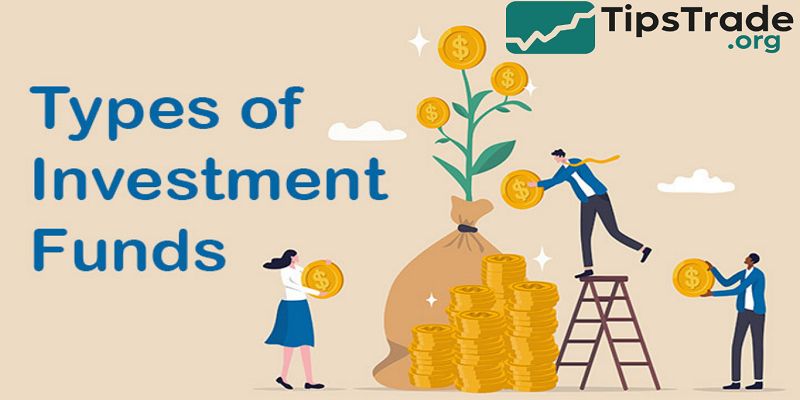Best funds offer investors a combination of strong performance, reliable management, and balanced risk. Choosing the best funds is essential for building a diversified and profitable investment portfolio that aligns with an individual’s financial goals and risk tolerance. Visit tipstrade.org and check out the article below for further information
Common Types of Investment Funds

Mutual Funds
Mutual funds are among the most widely used investment vehicles for both beginner and experienced investors. A mutual fund pools money from many investors and uses it to buy a diversified mix of securities such as stocks, bonds, or a combination of both.
This structure allows individuals to access professionally managed portfolios with relatively low minimum investment requirements.
According to Investopedia, mutual funds remain popular because they offer diversification and hands-off management, especially for long-term investors seeking stability.
The best mutual funds typically have low expense ratios, a strong track record, and consistent management.
Many investors compare actively managed mutual funds with passive ones to decide which aligns better with their goals.
Actively managed funds attempt to outperform the market through strategic stock selection, while passive mutual funds aim to mimic an index.
Beginners often appreciate the simplicity, but they should also review historical performance, volatility, and fund objectives. Mutual funds can be good choices for retirement accounts because they allow automatic reinvestment and long-term compounding.
Index Funds
Index funds are passive investment vehicles designed to track a specific market index such as the S&P 500, NASDAQ 100, or MSCI World Index.
They have grown massively in popularity because of their low cost, transparency, and historically strong performance compared to many actively managed funds. Vanguard research shows that low-cost index funds often outperform active funds over 10-year and 20-year periods due to minimal expenses and lower management risk.
Investors searching for the best index funds usually focus on fees, tracking accuracy, and fund size.
Lower expense ratios are critical because every fraction of a percent saved compounds over time. For example, a difference between 0.05% and 0.5% in fees may seem small but can accumulate significantly over decades.
Many long-term investors choose index funds as their core portfolio holdings because they provide broad exposure and reduce the need for constant monitoring.
These funds are ideal for people looking for a simple, reliable, and evidence-backed investment strategy
ETFs (Exchange-Traded Funds)
ETFs combine benefits of mutual funds and stocks, offering both diversification and the ability to trade throughout the day.
They are structured to track indexes, sectors, commodities, or thematic investment strategies. According to Morningstar, ETFs have seen rapid growth due to their transparency, low costs, and tax efficiency.
Many investors consider ETFs among the best funds for building diversified portfolios, especially when they want the flexibility to buy or sell during market hours.
ETF investors often look at trading volume, bid-ask spreads, and underlying index quality. Liquidity matters because it affects trading costs. ETFs also offer unique thematic options—technology, renewable energy, healthcare—which attract investors with specific interests.
Unlike mutual funds, ETFs do not require high minimum contributions, making them accessible even for beginners.
This flexibility allows users to implement advanced strategies such as dollar-cost averaging or tactical allocation. Overall, ETFs are suitable for individuals seeking low-cost, transparent, and flexible long-term investment vehicles.
Active Funds
Active funds are managed by professional portfolio managers who attempt to outperform the market by selecting high-potential investments.
They rely on research, analysis, and market forecasts. While fees for active funds are higher, some investors believe the potential for excess returns makes them worthwhile.
Morningstar research shows that a small portion of active funds consistently beat their benchmarks, especially in certain categories such as small-cap or emerging markets.
Investors evaluating active funds should review manager tenure, strategy consistency, risk-adjusted returns, and volatility.
Long-standing managers with clear investment frameworks often deliver better stability. Active funds can be beneficial when investors seek specialized strategies or exposure to inefficient markets where active management may add value.
However, they are also riskier because performance depends on manager skill and market conditions.
For beginners, active funds should complement—not replace—core passive holdings. A blended approach is often preferred.
Key Criteria for Evaluating the Best Funds

Expense Ratio (Costs)
The expense ratio is one of the most important factors when evaluating the best funds. It represents the annual fee charged by the fund to cover management and operational costs.
According to multiple studies from Vanguard and Fidelity, lower expenses are strongly linked to better long-term performance. Even a small fee difference can dramatically impact returns when compounding over decades.
Investors should compare expense ratios across similar fund categories. For example, index funds typically charge 0.02%–0.10%, while active funds may charge 0.5%–1.2% or more.
Paying higher fees only makes sense if an investor believes the fund manager can generate returns that justify the cost.
Transparency is essential, and trustworthy funds clearly disclose all fees. When selecting the best mutual funds or ETFs, choosing low-cost options often leads to more predictable and consistent long-term outcomes.
Performance & Manager Track Record
A fund’s historical performance is useful but should be interpreted carefully. Past performance does not guarantee future results, yet it provides insights into how a fund behaves during different market conditions.
Morningstar ratings are often used to assess risk-adjusted performance and manager consistency. Funds with long-term performance stability tend to be more reliable than those with short bursts of high returns.
Investors should review 5-year, 10-year, and since-inception returns. Consistency matters more than short-term gains. Additionally, the manager’s experience is crucial—long-tenured managers with strong track records offer greater trust.
Funds that outperform benchmarks over long periods often follow disciplined strategies, maintain transparent processes, and avoid unnecessary risks.
Evaluating risk metrics such as Sharpe ratio and volatility can also provide deeper insight into how the fund handles market fluctuations.
Risk Level & Diversification
Every investment fund comes with risk, but well-diversified funds can help reduce exposure to market volatility. Diversification spreads investments across sectors, industries, regions, or asset classes, lowering the impact of any single event.
According to Investopedia, broad index funds are among the safest fund types because they represent hundreds of companies at once.
Investors should consider whether a fund concentrates too heavily in one sector or region. Higher concentration increases risk, especially during market downturns.
For example, a technology-heavy growth fund may excel during bull markets but suffer significant losses during corrections. Meanwhile, diversified funds—such as total market or balanced funds—tend to offer smoother long-term performance.
Understanding one’s risk tolerance is essential: conservative investors may prefer bond funds or dividend funds, while aggressive investors may choose growth-focused funds.
Liquidity & Fund Size
Liquidity measures how easily an investment can be bought or sold without affecting its price.
ETFs generally offer high liquidity, while some mutual funds may have trading restrictions. Larger funds with high assets under management (AUM) provide stability and reduce the likelihood of unexpected closures.
Morningstar notes that funds with stable inflows and significant AUM tend to operate more efficiently and incur lower trading costs.
Fund size also influences diversification and management flexibility. Very small funds may face challenges in maintaining operations or acquiring enough assets to diversify properly.
Conversely, extremely large funds may be less agile when navigating volatile markets. Investors should look for funds with balanced size, reliable liquidity, and consistent investor interest.
These characteristics support long-term sustainability and reduce operational risk.
Investment Objective & Time Horizon
Understanding one’s investment goals is essential when choosing the best funds. Some individuals seek long-term growth, while others prioritize income, stability, or capital preservation.
A fund’s stated objective should align with the investor’s timeline. For example, growth funds focus on capital appreciation and may be suitable for younger investors with longer horizons. Income-focused investors may prefer dividend or bond funds with regular payouts.
Time horizon impacts risk tolerance. Long-term investors can generally endure more market volatility because they have time to recover from downturns.
Short-term investors may lean toward low-risk or balanced funds. Reading the fund’s prospectus is crucial to understanding objectives, holdings, and strategy.
Trustworthy providers clearly outline risks, expected behavior, and appropriate use cases to help investors choose wisely.
Examples of Popular High-Performing Funds

Top Index Funds
Index funds remain the most recommended option for long-term investors due to their reliability, low fees, and broad diversification.
Several well-known funds such as S&P 500 index funds, total stock market funds, and international index funds consistently rank among the best choices for beginners and experienced investors.
Vanguard and Fidelity publish research showing that low-cost index funds often outperform high-fee active funds over extended periods.
These funds are ideal for someone who wants a long-term, low-maintenance strategy.
Many retirement accounts use them as core holdings because they deliver stable performance with minimal effort. In addition to U.S. stock index funds, investors may consider international diversification through global index funds that track developed or emerging markets.
The transparency and low turnover make index funds a trustworthy, evidence-backed option for building long-term wealth.
Popular Active Funds
Active funds attract investors who believe skilled managers can outperform the market. Morningstar ratings often highlight select active funds that have demonstrated long-term consistency.
These funds typically focus on specific sectors, growth opportunities, or undervalued companies.
For example, well-managed active funds often outperform in niche markets where deep research and active decision-making can uncover hidden value.
However, active funds require careful evaluation. Investors should check whether strong performance is due to manager skill or simply favorable market conditions.
Reading manager commentary, reviewing risk-adjusted metrics, and understanding strategy consistency are essential.
Active funds may complement passive holdings by offering targeted exposure. They are best suited for individuals who understand the risks and want a diversified approach that includes both passive and actively managed strategies.
Notable Funds in Local Markets
In markets such as Vietnam or other emerging regions, many investors turn to local open-ended funds that specialize in domestic equities.
These funds can provide exposure to growing sectors such as banking, real estate, consumer goods, and technology.
Local fund managers often possess insights unavailable in international markets, making them attractive for investors seeking regional opportunities.
When selecting local funds, investors should examine management transparency, regulatory compliance, and long-term performance.
Expense ratios, turnover rates, and dividend policies also matter. Because emerging markets tend to be more volatile, diversification across both domestic and global funds can reduce risk and create a more balanced portfolio.
Trustworthiness is key, and investors should look for funds operated by reputable financial institutions with strong governance standards.
Investment Strategies Using the Best Funds
Dollar-Cost Averaging (DCA)
Dollar-cost averaging is one of the simplest and most effective strategies for long-term investors.
It involves investing a fixed amount of money at regular intervals, regardless of market conditions.
Research from financial institutions such as Fidelity shows that DCA helps reduce emotional decision-making and lowers the average purchase price during market dips.
This method is especially powerful when applied to index funds or ETFs with long-term growth potential.
DCA is ideal for beginner investors because it builds discipline and consistency. Market timing becomes less important, and investors avoid the risk of entering the market at unfavorable moments.
Additionally, DCA fits well with salary-based investing, where individuals contribute a portion of income monthly. It is not a strategy that guarantees higher returns, but it provides smoother market entry and reduces the psychological stress of volatility.
Portfolio Construction
Building a successful investment portfolio involves combining different fund types based on goals, risk tolerance, and time horizon.
A common approach is using a core-satellite structure: index funds serve as the stable core, while active funds or thematic ETFs act as satellites for targeted exposure.
This method balances risk, cost, and potential growth.
Investors should diversify across asset classes, including equities, bonds, international markets, and alternative investments when appropriate.
Portfolio construction also considers age-based allocation; younger investors often tilt toward growth funds, while older individuals may shift toward income or balanced funds.
Transparency, liquidity, and low fees contribute to overall trustworthiness. A well-constructed portfolio reduces the need for constant monitoring and allows long-term compounding to work effectively.
Rebalancing and Monitoring
Rebalancing ensures the portfolio stays aligned with the investor’s target allocation. Over time, certain assets may grow faster than others, shifting the risk level.
Rebalancing typically involves selling a portion of overweight assets and buying underweight ones.
Studies from Vanguard indicate that periodic rebalancing—such as once per year—can reduce volatility and improve risk-adjusted returns.
Monitoring progress helps investors stay aware of performance trends, market conditions, and changes in personal goals. However, monitoring does not mean reacting emotionally to short-term fluctuations.
Trustworthy investing involves patience, discipline, and long-term planning. Investors who rebalance regularly avoid excessive risk exposure and maintain a more stable trajectory toward their financial objectives.
Common Mistakes When Choosing Funds

Many investors make predictable errors when selecting funds. One common mistake is choosing a fund based solely on recent high performance.
High returns may reflect temporary market conditions rather than long-term quality. Another mistake is ignoring expense ratios, which can significantly reduce net returns over time. Transparency and cost awareness are essential when evaluating funds.
Some investors also lack diversification, placing too much money in a single sector, region, or high-risk theme.
Others choose funds that do not match their time horizon or risk tolerance. Reading the fund prospectus and understanding objectives can prevent mismatches.
Finally, emotional decision-making—selling during downturns or chasing trends—creates long-term damage. A disciplined approach helps avoid these pitfalls and supports sustainable wealth-building.
Conclusion
Best funds stand out because they consistently deliver value and stability even during market fluctuations. By carefully researching and selecting these top-performing funds, investors can maximize their potential returns while minimizing risks.

